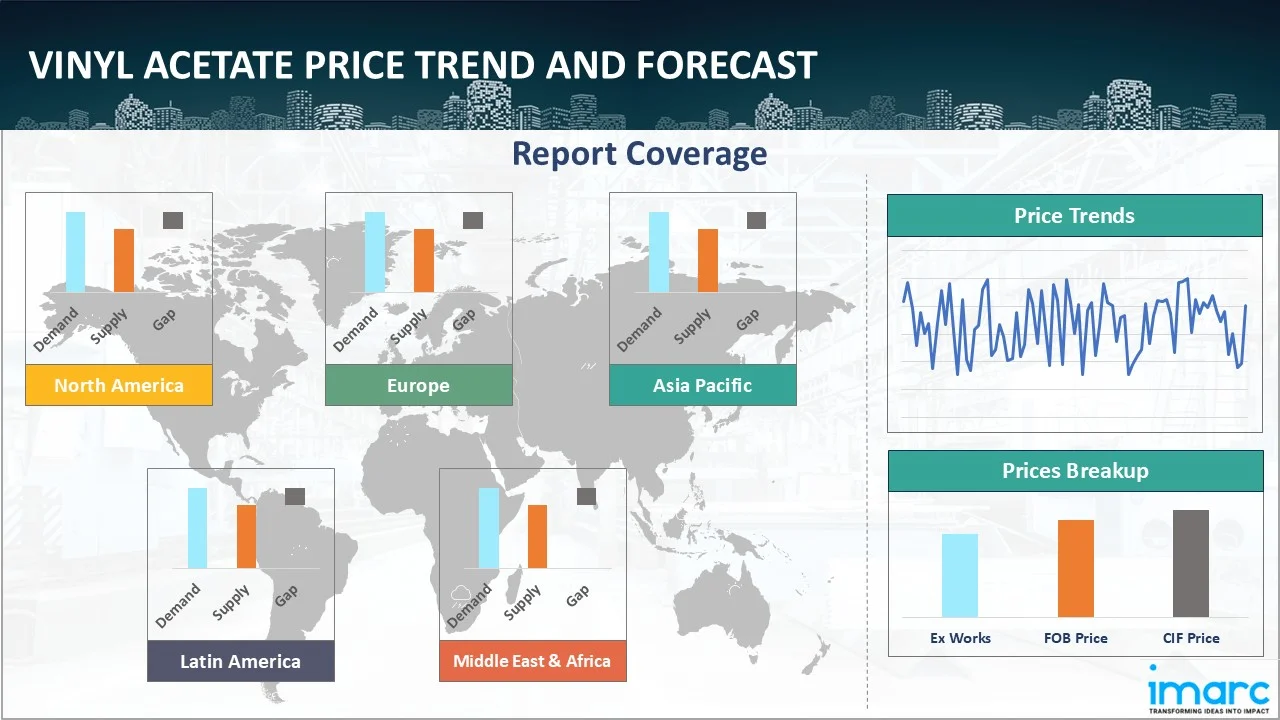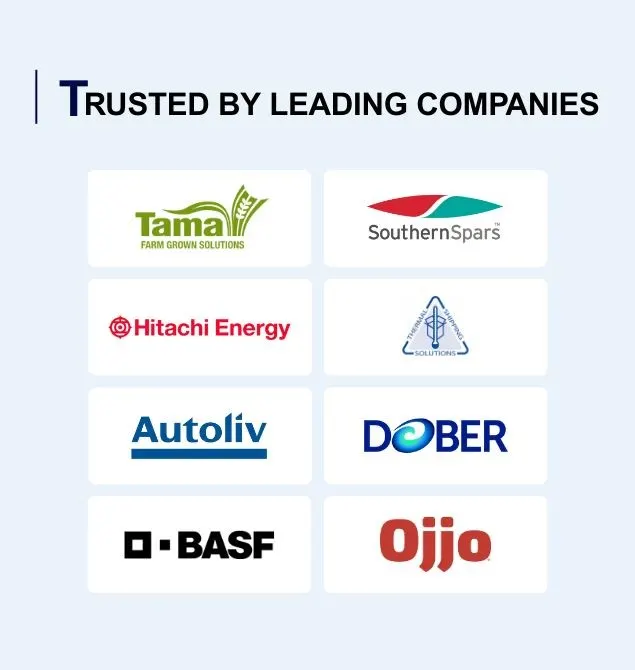
Vinyl Acetate Prices, Trend, Chart, Demand, Market Analysis, News, Historical and Forecast Data Report 2025 Edition
Vinyl Acetate Price Trend, Index and Forecast
Track real-time and historical vinyl acetate prices across global regions. Updated monthly with market insights, drivers, and forecasts.
Vinyl Acetate Prices October 2025
| Region | Price (USD/Kg) | Latest Movement |
|---|---|---|
| Northeast Asia | 0.97 | 16.7% ↑ Up |
| Europe | 1.12 | 4.6% ↑ Up |
| Middle East | 0.90 | 6.9% ↑ Up |
| Southeast Asia | 0.94 | -1.9% ↓ Down |
| North America | 1.21 | 3.5% ↑ Up |
Vinyl Acetate Price Index (USD/KG):
The chart below highlights monthly vinyl acetate prices across different regions.

Get Access to Monthly/Quaterly/Yearly Prices, Request Sample
Market Overview Q3 Ending September 2025
Northeast Asia: Vinyl acetate prices in Northeast Asia declined, largely due to weak downstream demand from adhesives and coatings industries in China, Japan, and South Korea. High operating rates at Chinese VAM plants created oversupply, while subdued construction sector activity curbed domestic consumption. On the supply side, stable acetic acid and ethylene feedstock costs minimized upward price pressure, though port congestion marginally increased logistics costs. The fluctuation of the Chinese yuan against the US dollar reduced export competitiveness, leading producers to lower offers in regional markets.
Europe: High natural gas costs continued to pressure production economics, raising feedstock expenses for ethylene and acetic acid producers. Supply-side challenges persisted due to scheduled plant maintenance in Germany and France, which reduced local output. However, cheaper imports from Asia undercut regional producers, prompting discounts to maintain market share. Currency fluctuations, particularly the weaker euro against the US dollar, inflated import bills, but buyers resisted higher offers due to weak downstream uptake. Inland logistics inefficiencies, including trucking shortages across Eastern Europe, further contributed to distribution delays and cost escalations.
Middle East: Consistent domestic demand from the packaging and adhesives sectors in Saudi Arabia and the UAE supported price levels. Feedstock availability remained steady as regional methanol and acetic acid producers operated at near-optimal rates, ensuring balanced supply conditions. Export activity toward South and Southeast Asia increased marginally, reflecting stronger buying interest from emerging markets. Energy subsidies in Gulf economies helped cushion production costs despite elevated oil prices. However, limited shipping container availability at Jebel Ali port caused sporadic delivery delays.
Southeast Asia: Rising construction activity, particularly in Indonesia’s infrastructure projects, boosted VAM demand. On the supply side, temporary disruptions in Malaysia’s petrochemical hubs due to monsoon-related flooding reduced regional production and tightened availability. This supply imbalance widened the gap between demand and supply, supporting bullish price sentiment. Additionally, higher import costs, driven by container shortages and increased freight charges on major shipping routes, amplified upward movement.
North America: Downstream sectors such as adhesives, paints, and automotive coatings reported reduced consumption due to slowing construction and manufacturing activities. Feedstock acetic acid prices softened, easing production costs for VAM producers. Nevertheless, logistical challenges persisted, with rail congestion and hurricane-related disruptions in the Gulf region affecting distribution schedules. A strong US dollar further incentivized imports, undermining regional price stability as domestic producers struggled to defend margins against cheaper Asian cargoes.
Vinyl Acetate Price Trend, Market Analysis, and News
IMARC's latest publication, “Vinyl Acetate Prices, Trend, Chart, Demand, Market Analysis, News, Historical and Forecast Data Report 2025 Edition,” presents a detailed examination of the vinyl acetate market, providing insights into both global and regional trends that are shaping prices. This report delves into the spot price of vinyl acetate at major ports and analyzes the composition of prices, including FOB and CIF terms. It also presents detailed vinyl acetate prices trend analysis by region, covering North America, Europe, Asia Pacific, Latin America, and Middle East and Africa. The factors affecting vinyl acetate pricing, such as the dynamics of supply and demand, geopolitical influences, and sector-specific developments, are thoroughly explored. This comprehensive report helps stakeholders stay informed with the latest market news, regulatory updates, and technological progress, facilitating informed strategic decision-making and forecasting.

Vinyl Acetate Industry Analysis
The global vinyl acetate industry size reached USD 9.35 Billion in 2024. By 2033, IMARC Group expects the market to reach USD 14.13 Billion, at a projected CAGR of 4.40% during 2025-2033. The market is driven by the robust demand in adhesives and sealants, rising consumption in paints and coatings, growing use in solar encapsulants, and expanding applications in packaging films and textiles.
Latest developments in the Vinyl Acetate Industry:
- September 2025: Kuraray acquired ISCC PLUS certification at three sites in Japan, the Okayama, Kurashiki, and Saijo plants, thereby establishing a certified supply chain for five vinyl acetate related products within the country. These products included vinyl acetate monomer (VAM), PVOH resin, PVOH film, EVOH resin, and EVOH film. The certification enabled Kuraray to allocate sustainable raw materials using the mass balance method across its domestic vinyl acetate operations.
- November 2024: Kuraray Co., Ltd. announced that six vinyl acetate-related products at four Group companies across production bases in the United States and Europe have been certified under ISCC PLUS*1, which is an internationally recognized sustainable product certification program.
Product Description
Vinyl acetate (CH₂CHOCOCH₃) is a colorless, flammable liquid chemical compound primarily used as a monomer in polymer production. It is synthesized through the reaction of ethylene with acetic acid and oxygen over a palladium catalyst. Vinyl acetate holds a critical position in the global petrochemical chain as a precursor for producing polyvinyl acetate (PVA), polyvinyl alcohol (PVOH), and ethylene-vinyl acetate (EVA). These derivatives play a vital role in adhesives, coatings, textiles, packaging films, and construction applications. Its key attribute lies in enhancing flexibility, adhesion, and durability in end-use products, making it an indispensable intermediate in multiple industrial sectors.
Report Coverage
| Key Attributes | Details |
|---|---|
| Product Name | Vinyl Acetate |
| Report Features | Exploration of Historical Trends and Market Outlook, Industry Demand, Industry Supply, Gap Analysis, Challenges, Ammonium Perchlorate Price Analysis, and Segment-Wise Assessment. |
| Currency/Units | US$ (Data can also be provided in local currency) or Metric Tons |
| Region/Countries Covered | The current coverage includes analysis at the global and regional levels only. Based on your requirements, we can also customize the report and provide specific information for the following countries: Asia Pacific: China, India, Indonesia, Pakistan, Bangladesh, Japan, Philippines, Vietnam, Thailand, South Korea, Malaysia, Nepal, Taiwan, Sri Lanka, Hongkong, Singapore, Australia, and New Zealand* Europe: Germany, France, United Kingdom, Italy, Spain, Russia, Turkey, Netherlands, Poland, Sweden, Belgium, Austria, Ireland, Switzerland, Norway, Denmark, Romania, Finland, Czech Republic, Portugal and Greece* North America: United States and Canada Latin America: Brazil, Mexico, Argentina, Columbia, Chile, Ecuador, and Peru* Middle East & Africa: Saudi Arabia, UAE, Israel, Iran, South Africa, Nigeria, Oman, Kuwait, Qatar, Iraq, Egypt, Algeria, and Morocco* *The list of countries presented is not exhaustive. Information on additional countries can be provided if required by the client. |
| Information Covered for Key Suppliers |
|
| Customization Scope | The report can be customized as per the requirements of the customer |
| Report Price and Purchase Option |
Plan A: Monthly Updates - Annual Subscription
Plan B: Quarterly Updates - Annual Subscription
Plan C: Biannually Updates - Annual Subscription
|
| Post-Sale Analyst Support | 360-degree analyst support after report delivery |
| Delivery Format | PDF and Excel through email (We can also provide the editable version of the report in PPT/Word format on special request) |
Key Benefits for Stakeholders:
- IMARC’s report presents a detailed analysis of vinyl acetate pricing, covering global and regional trends, spot prices at key ports, and a breakdown of FOB and CIF prices.
- The study examines factors affecting vinyl acetate price trend, including input costs, supply-demand shifts, and geopolitical impacts, offering insights for informed decision-making.
- The competitive landscape review equips stakeholders with crucial insights into the latest market news, regulatory changes, and technological advancements, ensuring a well-rounded, strategic overview for forecasting and planning.
- IMARC offers various subscription options, including monthly, quarterly, and biannual updates, allowing clients to stay informed with the latest market trends, ongoing developments, and comprehensive market insights. The vinyl acetate price charts ensure our clients remain at the forefront of the industry.
Key Questions Answered in This Report
The vinyl acetate prices in October 2025 were 0.97 USD/Kg in Northeast Asia, 1.12 USD/Kg in Europe, 0.90 USD/Kg in the Middle East, 0.94 USD/Kg in Southeast Asia, and 1.21 USD/Kg in North America.
The vinyl acetate pricing data is updated on a monthly basis.
We provide the pricing data primarily in the form of an Excel sheet and a PDF.
Yes, our report includes a forecast for vinyl acetate prices.
The regions covered include North America, Europe, Asia Pacific, Middle East, and Latin America. Countries can be customized based on the request (additional charges may be applicable).
Yes, we provide both FOB and CIF prices in our report.
Need more help?
- Speak to our experienced analysts for insights on the current market scenarios.
- Include additional segments and countries to customize the report as per your requirement.
- Gain an unparalleled competitive advantage in your domain by understanding how to utilize the report and positively impacting your operations and revenue.
- For further assistance, please connect with our analysts.
Why Choose Us
IMARC offers trustworthy, data-centric insights into commodity pricing and evolving market trends, enabling businesses to make well-informed decisions in areas such as procurement, strategic planning, and investments. With in-depth knowledge spanning more than 1000 commodities and a vast global presence in over 150 countries, we provide tailored, actionable intelligence designed to meet the specific needs of diverse industries and markets.
1000
+Commodities
150
+Countries Covered
3000
+Clients
20
+Industry
Robust Methodologies & Extensive Resources
IMARC delivers precise commodity pricing insights using proven methodologies and a wealth of data to support strategic decision-making.
Subscription-Based Databases
Our extensive databases provide detailed commodity pricing, import-export trade statistics, and shipment-level tracking for comprehensive market analysis.
Primary Research-Driven Insights
Through direct supplier surveys and expert interviews, we gather real-time market data to enhance pricing accuracy and trend forecasting.
Extensive Secondary Research
We analyze industry reports, trade publications, and market studies to offer tailored intelligence and actionable commodity market insights.
Trusted by 3000+ industry leaders worldwide to drive data-backed decisions. From global manufacturers to government agencies, our clients rely on us for accurate pricing, deep market intelligence, and forward-looking insights.
 Request Customization
Request Customization
 Inquire Before Buying
Inquire Before Buying
 Speak to an Analyst
Speak to an Analyst Request Brochure
Request Brochure




.webp)




.webp)












